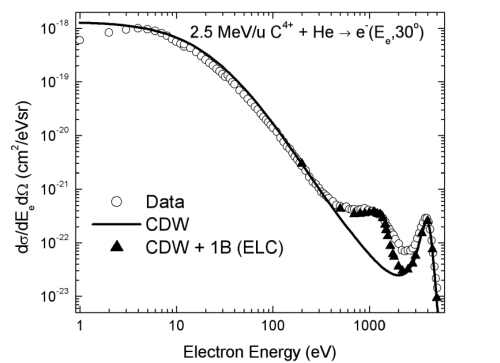
Figure 1:
DDCS for 2.5 MeV/u C4+ + He collisions. Open circles are measured data,
solid line is CDW theory, solid triangles are CDW plus first Born calculation of ELC
for a projectile beam containing a 10% 1s2s(3S) metastable
component.
IONIZATION AND ELECTRON LOSS TO THE CONTINUUM IN COLLISIONS
OF 2.5 MEV/U C4+ IONS WITH HELIUM ATOMS
M. W. Gealya, H. Aliabadib, L. Gulyásc and P. Richardb
a Concordia College, Moorhead, Minnesota, USA
bJ.R. Macdonald Laboratory, Department of Physics, Kansas State University, Manhattan, KS, USA cInstitute of Nuclear Research, Hungarian Academy of Science (ATOMKI), Debrecen, HungaryRecently we reported preliminary absolute cross-section data for electron emission, doubly differential in electron energy and angle, in collisions of 2.5 MeV/u C5+ and C4+ ions with helium atoms.Electron energy spectra for the case of C4+ impact exhibit broad electron-loss-to-the-continuum (ELC) peaks centered at about 1200 eV (essentially independent of scattering angle). These ELC features, very prominent in the forward direction and decreasing rapidly with scattering angle, are discernable at virtually all angles.
The width, energy and angular dependence of the observed ELC peaks suggest that they arise partly from the metastable 1s2s(3S) state of the projectile ions.The Compton profile of the 1s2 (1S) ground state is relatively broad therefore leading to a broader distribution of ELC electrons than those due to the metastable 1s2s (3S) state.
Projectiles are prepared in the tandem Van de Graaff accelerator at KSU. Negative carbon ions are extracted from a sputter ion source and accelerated to a terminal at 6.0MV where they pass through a gas cell containing N2 in which electrons are stripped.Positive ions exiting the cell are further accelerated, charge-state selected and directed into the target chamber.
The target chamber is that described by Gealy et al A magnetically shielded chamber is flooded with helium to a pressure of approximately 0.1mT. Electrons are energy selected by a hemispherical electrostatic analyzer with resolutions of 5.0% in energy and ±1.1° in angle. The range of electron energies and angles surveyed is 1.0 eV to 6.0 keV, and 15° to 160° respectively.
The present theoretical work includes two components. Target ionization is modeled with Continuum Distorted Wave (CDW) calculations assuming a bare projectile with an effective charge of 5.02. Projectile ELC is modeled with a first Born approximation calculation assuming a projectile consisting of a mixture of 1s2 and 1s2s(3S) ions.
A weighted fit of the theoretical calculations to the data suggests that the beam contains a metastable fraction of approximately 10%. The observed dependence of the ELC features on scattering angle is very accurately reflected in the calculations. Future work will include an independent experimental assessment of this fraction.When this is accomplished we will be able to present corrected absolute cross sections for ground-state C4+ impact on helium.
Figures:

Figure 1:
DDCS for 2.5 MeV/u C4+ + He collisions. Open circles are measured data,
solid line is CDW theory, solid triangles are CDW plus first Born calculation of ELC
for a projectile beam containing a 10% 1s2s(3S) metastable
component.
References:
1) M. W. Gealy, H. Aliabadi, L. Gulyás, P. Richard, J. E. Schauer and Amanda J. Kerstein,
Bull. Am. Phys. Soc. 75, 86, (2000).
2) M. W. Gealy, G. W. Kerby III, Ying-Yuan Hsu, and M. E. Rudd, Phys. Rev. A, 51, 2247, (1995).
This work was supported by the
Chemical Sciences, Geosciences and Biosciences Division,
Office of Basic Energy Sciences,
Office of Science,
U.S. Department of Energy.
Submitted to ICPEAC 2001, July 2001 in Santa Fe, NM.
This abstract is also available in Postscript or Adobe Acrobat formats.
|
|